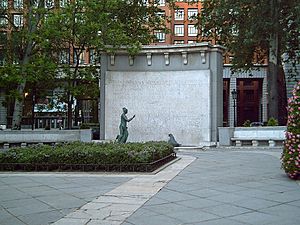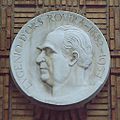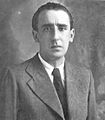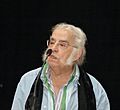Art and culture in Francoist Spain facts for kids

You have to impose, in short, the order of culture, the essential ideas that have inspired our glorious movement, which combine the purest lessons of universal and Catholic tradition with the demands of modernity
Art and culture in Francoist Spain refers to the art and culture created in Spain during the time of Franco's rule (1939–1975). This period followed the Spanish Civil War. While some art directly supported Franco's government, much of it was created by artists who did not agree with his ideas or simply focused on their art without political aims.
Some people use terms like 'Fascist art' or 'Falangist art' to describe the art that was very closely linked to Franco's government and its political party, the Falange. However, these terms usually apply to a smaller part of the art from that time.
Contents
Artists and Their Choices
Many artists and thinkers lived and worked in Spain during Franco's rule. Some supported the government, like writers José María Pemán and Luis Rosales, or painters Carlos Sáenz de Tejada.
However, many other artists did not support Franco's ideas. They created art that was either against the government or simply focused on different themes. These artists included writers like Carmen Laforet and Antonio Buero Vallejo, famous painters like Salvador Dalí and Joan Miró, and filmmakers like Luis García Berlanga.
Internal and External Exile
Many artists who disagreed with Franco faced difficult choices. Some stayed in Spain but lived in a kind of "internal exile." This meant they continued their work but often felt isolated or had limited freedom to express themselves. Writers like Vicente Aleixandre are often seen as examples of internal exile.
Others left Spain completely, going into "external exile." These were often people who had supported the Spanish Republic before Franco took power. Famous figures like painter Pablo Picasso, cellist Pablo Casals, and filmmaker Luis Buñuel lived outside Spain during this time. They continued to create important works that gained international fame.
The government, especially later on, sometimes tried to be more open to cultural works that weren't directly against them. This was an effort to show a more modern image of Spain to the world.
Controlling Culture and Education
After the Civil War, Franco's government wanted to create a new culture based on Spanish nationalism and Catholic traditions. They aimed to control what people learned and what art was created.
Schools and Universities
The government took strong control over schools and universities. They removed teachers and professors who didn't support the new regime. Many educators were punished, and some even died or went into exile. For example, a large number of professors from the University of Madrid were disciplined.
Universities were reorganized to fit the government's ideas. Leaders of universities had to be members of the Falange party. The government also used media like newsreels (No-Do), newspapers, and later TV, to spread its messages and control information.
Important cultural institutions were also affected. The Real Academia Española (Royal Spanish Academy), which focuses on the Spanish language, saw its director resign. Other places like the Museo del Prado (a famous art museum) and the Ateneo de Madrid (a cultural center) also came under government influence. New organizations were created, like the CSIC, to replace older, more independent ones.
Centralizing Cultural Control
The government tried to limit regional languages and cultures, like Catalan and Basque, in public life and education. They promoted Castilian Spanish as the main language.
Different groups within Franco's government (like Catholics, Falangists, and monarchists) had control over different areas. For example, Catholics often managed education, while Falangists controlled media and propaganda. The Church played a big role, gaining control over teaching in exchange for its support of the regime.
Many Catholic leaders and thinkers gained important positions in culture and education. Their ideas, often based on older religious philosophies, became very influential.
Literature in Francoist Spain
The Spanish Civil War deeply affected Spanish culture and literature. Many important writers died during or shortly after the war, like Federico García Lorca and Miguel Hernández.
The Cultural Landscape
The years after the war (the 1940s and 1950s) were a tough time for culture in Spain. The country was recovering from the war, and there was a lot of censorship and control over books and ideas. This period is often called a "cultural wasteland" compared to the rich cultural period before the war.
However, even in these difficult times, important works were created. Some writers, like Carmen Laforet with her novel Nada (meaning "Nothing"), captured the feeling of emptiness and struggle.
Many famous writers from the "Generation of '27" (a group of poets from the 1920s) went into exile, like Luis Cernuda and Rafael Alberti. Others, like Vicente Aleixandre, stayed in Spain but continued their work quietly. Spanish exiles achieved great success abroad, with Juan Ramón Jiménez winning the Nobel Prize for Literature in 1956.
Some writers were closely linked to Franco's government, while others tried to find a middle ground. Over time, some intellectuals who initially supported the regime began to distance themselves. New literary movements also emerged, like "tremendismo," which showed the harsh realities of life.
-
Eugenio d'Ors monument in Madrid.
-
Monument to Gerardo Diego.
-
Josep Pla and Catalán language writer Manuel Brunet.
The "Openness" Era
Later in Franco's rule, especially from the 1960s onwards, Spain started to change. Economic growth, tourism, and more contact with other countries led to some relaxation of strict controls.
The Ministry of Information and Tourism, led by Manuel Fraga, brought in a new law in 1966 that made censorship a bit less strict. The Catholic Church, which had been a strong supporter of Franco, also began to distance itself after the Vatican II Council.
Newspapers and magazines like Diario Madrid and Triunfo pushed the limits of censorship, becoming important voices for political and cultural discussion. Universities also became places where opposition to Franco grew stronger, with student protests and professors being punished for their views.
-
Monument to Enrique Tierno Galván.
The events of 1968, which saw protests around the world, also affected Spain's universities. This period showed that many people, especially young people, wanted more freedom and change.
-
Monument to Antonio Buero Vallejo.
-
Monument to Gonzalo Torrente Ballester.
-
Plaque dedicated to Miguel Delibes.
-
Plaque dedicated to Salvador Espriu.
-
Monument to Celso Emilio Ferreiro.
See also
 In Spanish: Arte y cultura en el franquismo para niños
In Spanish: Arte y cultura en el franquismo para niños




















